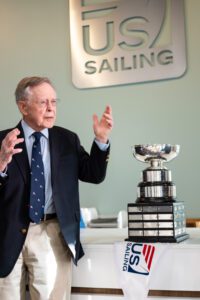On a crisp autumn day, Edward Bursk, now 92 years old, journeyed to the US Sailing offices in Bristol, RI, to take a photo with the trophy that cemented his name in sailing history—the Sears Cup. Seventy-five years ago, at the age of 17, Bursk and his team from Cohasset Yacht Club claimed victory in this prestigious youth championship, leaving an indelible mark on the sport.

For Bursk, the Sears Cup wasn’t just a trophy, it was a reflection of a lifelong love for sailing, cultivated from a young age at Cohasset Yacht Club. “Kingsley Durant, Frank Cahouet, and I grew up sailing in Cohasset before and during World War II,” Bursk reminisced. He recalls learning to sail in small wooden boats called “rookies,” with barely enough room for one sailor and a packed lunch. It was a humble start, but it laid the foundation for a future of competitive sailing.
By 1949, after years of honing their skills, Bursk and his team —Kingsley Durant and Frank Cahouet—were ready to compete for the Sears Cup. Encouraged by Ray Hunt, a two-time Sears Cup champion and renowned designer of the 110 and 210 classes, the team embarked on a journey to the competition held in Vineyard Haven. Bursk recalls the intimidating start: “The first race was called off after two starts were cancelled and several sails ripped off their tracks by a breeze that went from 30 to 40 knots.” Despite the wild conditions, their confidence grew when they won the first official race.
The competition was fierce, with a particular focus on Doug Cassel, the 1948 champion sailing in his home waters. “My assigned duties became spotting the start, setting the spinnaker, and knowing where Doug Cassel was at all times,” Bursk explained. Tactics and determination paid off as the team consistently finished near the top, including a memorable seventh race where they narrowly avoided a collision with a tugboat towing a massive barge. “We didn’t want to jibe back to the fleet chasing us, but we didn’t want to pitch pole over a huge wire hawser either. It was one of those moments where you just trust your gut—and a little divine providence,” Bursk recalled with a grin.

Bursk’s win in the Sears Cup was a milestone in what would become a remarkable life. From serving his country as a Navy officer and covert operative to becoming President of Raytheon International, Bursk has navigated both the world of sailing and global business with the same precision and calm he learned on the water. “I have sailed boats all my life, and both the most excitement and the most peace I have ever felt was on a sailboat somewhere on an ocean, a sea, a bay, a lake, a loch, or a river.”
Though decades have passed since his Sears Cup victory, Edward Bursk’s visit to Bristol was more than just a reunion with a trophy. It was a reflection on a sport that, like the man himself, has evolved yet remains deeply rooted in tradition. And for Bursk, the calm of the sea and the thrill of competition are feelings that never fade, no matter how many years pass since that unforgettable summer of 1949.



